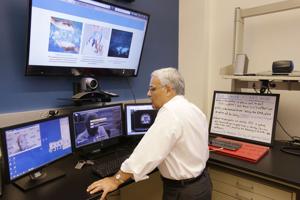Op-Ed: With right policies, patients can continue to rely on the digital domain

To millions of Americans requiring medical treatment during the coronavirus pandemic, telehealth services have provided a safe and affordable alternative to the status-quo of in-person appointments. The need was immense.
In the early weeks and months of COVID-19 lockdowns, some health systems reported that non-urgent virtual care visits surged more than 4,000 percent. These numbers have come down quite a bit since then but remain far higher than pre-pandemic norms. According to a recent analysis by consultancy McKinsey, “telehealth utilization has stabilized at levels 38X higher than before the pandemic.” Physicians can cater to this bolstered demand for virtual visits, but continuing regulatory and payment barriers are making doctors think twice before logging onto the digital domain. Federal and state policymakers can put patient needs first by setting clear and concise rules on telehealth.
When the coronavirus pandemic first forced everyone inside, officials across the country rushed to roll back rules getting in the way of patients’ healthcare. From Massachusetts to Florida, states quickly stepped up and allowed out-of-state doctors to offer telehealth services to state residents without having to go through normal state licensure requirements. The Department of Health and Human Services followed suit, granting healthcare providers wider latitude to treat Medicare and Medicaid patients across state lines and use popular applications to deliver telehealth without fear of complicated rules.
But, as things gradually slide back to “normal,” there are some early signs of a regulatory reversal. After Alabama ended its COVID-spurred state of emergency, residents suddenly found themselves unable to access out-of-state virtual care. This sudden change in the rules has led to unfortunate situations where families relying on far-away medical specialists have had to travel across the country to receive continued care. Renewed restrictions also don’t bode well for taxpayers who have to dole out tens of millions of dollars to maintain telehealth access across underserved communities. More red tape means that those dollars will stretch less far in helping vulnerable patients get the care they need.
Other state-level changes are more encouraging, yet still create a specter of uncertainty for millions of patients. For example, New York’s Medicaid program is continuing to cover virtual health services even after the state has rolled back its emergency waiver of telehealth funding rules. This coverage continuation not only gives low-income residents more healthcare options but will likely save Empire State taxpayers billions of dollars because telehealth tends to be less expensive than ordinary care. By some estimates, telehealth costs are nearly 50 percent lower than in-person visits. However, this sustained coverage and resulting cost savings will only last for the duration of the federal Public Health Emergency. There remains the disturbing prospect that patients could suddenly find themselves without virtual medical access once the federal government declares the emergency over.
Rules at the federal level are also complicating patient access to telehealth. Even though healthcare researchers have recommended a hybrid model of in-person and virtual visits for Medicare home health beneficiaries, the federal government has still not allowed these patients to access telehealth services. Medicare has bolstered the scope of reimbursable telehealth services, but billing changes are centered around rural patients already in medical facilities. A broader-based reimbursement system for telehealth can deliver substantial savings for taxpayers and patients over the long-term.
Clearly, it will take a while for the federal government and states to figure out exactly which services should be permitted and reimbursable by taxpayer-funded insurance programs. Policymakers should keep an open mind and commit to innovative technologies that can lead to better, more affordable care.
With the right policies, the healthcare system can finally pivot toward the digital domain and make lifesaving services accessible to millions of Americans.
Disclaimer: This content is distributed by The Center Square


